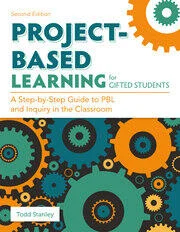PBL and Inquiry Learning for Gifted Students
Project-Based Learning for Gifted Students: A Step-By-Step Guide to PBL and Inquiry in the Classroom (2nd ed.)
By Todd Stanley
(Routledge/Prufrock Press, 2021 – Learn more)
Reviewed by Erin Corrigan-Smith


Todd Stanley is a prolific writer and teacher who has worked in education for over 18 years. He often focuses his books on exploring topics such as addressing student motivation and engaging with gifted learners. The fantastic thing about PBL is that it easily lends itself to differentiation, so that students at almost any level can advance their learning with effective PBL instruction.
Effective Use of PBL
In Project-Based Learning for Gifted Students – A Step-By-Step Guide to PBL and Inquiry in the Classroom, Stanley breaks down what PBL is and how to effectively implement it in almost any academic setting. The flexibility of PBL also allows for exploration beyond the classroom, so students can synthesize learning from across disciplines.
An important thing to note about this book is that it is not concentrated on specific PBL assignments, but rather it offers an overview for educators on how to effectively use PBL in the classroom. There are multitudes of resources available that give examples of PBL projects, but this resource is focused on helping the educator create his/her own PBL initiative to address specific student needs and interests.
Project-Based Learning for Gifted Students is organized into logical chapters that progress from an explanation of what PBL is to ideas on how to manage projects in the classroom. Each chapter builds upon the information from the preceding one, though it is possible to begin at any step.
Winning Appendices
Perhaps my favorite part of the text is the appendices which contain reproducible worksheets and examples of effective PBL assessments that Stanley has used. One of the best features of PBL is that it encourages students to create their own assessment criteria, and Stanley has included a blank rubric (with several completed ones to use as examples) for students to use to determine how they wish to be assessed. It’s a great way to increase buy-in for any PBL project because the students determine the criteria.
This book is an ideal resource for a teacher new to PBL or for someone who wishes to review key aspects of effective PBL Overall, this is an excellent introduction to PBL and a good resource for anyone interested in expanding their PBL understanding.
See Erin’s review of Stanley’s A Teacher’s Toolbox for Gifted Education: 20 Strategies You Can Use Today to Challenge Gifted Students here.
Erin Corrigan-Smith is a secondary ELA teacher in a suburb of Atlanta. She has a B.A. and M.A. in English, and her focus of study is children’s literature. She has recently returned to school to earn an Ed.D. in Reading and Literacy. In her downtime, she enjoys going to her family’s cabin in the North Georgia mountains, with her husband and dog, to read, to complete her never-ending piles of homework, and to relax.






























